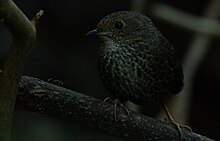| Nepal cupwing | |
|---|---|

| |
| at Dehradun, India | |
| Conservation status | |
 Least Concern (IUCN 3.1) | |
| Scientific classification | |
| Domain: | Eukaryota |
| Kingdom: | Animalia |
| Phylum: | Chordata |
| Class: | Aves |
| Order: | Passeriformes |
| Family: | Pnoepygidae |
| Genus: | Pnoepyga |
| Species: | P. immaculata |
| Binomial name | |
| Pnoepyga immaculata Martens & Eck, 1991 | |

| |
The Nepal cupwing (Pnoepyga immaculata), also known as the Nepal wren-babbler or immaculate cupwing, is a small species of passerine bird in the family Pnoepygidae. It is native to Uttarakhand, Himachal Pradesh, Tibet, and Nepal. It is found in dense montane forest in the Himalayas.
Nomenclature and taxonomy
The Nepal cupwing is in the genus Pnyoepyga. Its closest relatives are the scaly-breasted cupwing, Taiwan cupwing, and pygmy cupwing. It was first described by Jochen Martens and Siegfried Eck in 1991, having been identified as a separate species based on differences in voice. Genetic phylogeny suggests that it forms a clade with the pygmy cupwing. No subspecies have been described. It was formerly classified, with the other cuplings, as an Old World babbler in the family Timaliidae until 2009, when the monotypic family Pneopygidae was created for the cupwings, reflecting recent developments in molecular phylogeny.
The name "Nepal cupwing" is used by the International Ornithologist's Union and by the Handbook of the Birds of the World, while "immaculate cupwing" is used in American English and in Indian English, including The Clements Checklist of Birds of the World. The name "Nepal wren-babbler' was formerly used by these taxonomic authorities but is no longer in official use.
Description
The Nepal cupwing is small, measuring 8.5cm—10cm in length, and is brownish-olive in colouration. It has dark scaling on the upperparts and paler scaling on the underparts, a scaly breast with brown central feathers, pale edging on the flight feathers, and a very short tail. External morphology is very similar to the other species, to a degree where identification within the field relies upon vocalizations. The song is distinctive, being higher pitched than the other species in the genus and consisting of a steady series of thin, short, rapid, modulated whistles that descend in pitch.
Distribution and habitat
This species is native to the foothills of the Himalayas. It is a regular resident in Uttarakhand, Himachal Pradesh, and Nepal, and an uncommon resident around Zhangmu in Tibet. Preferred habitat is dense understorey in median and low mountain elevations. It is not migratory, but altitudinal movements do occur, as they winter down to 250 metres. It occurs regularly between 1800 and 2200 metres, and possibly breeds as high as 3100 metres. Generally, this species prefers dark forest and keeps to the forest floor. Its conservation status is Least Concern.
References
- BirdLife International (2016). "Pnoepyga immaculata". IUCN Red List of Threatened Species. 2016: e.T22716104A94481002. doi:10.2305/IUCN.UK.2016-3.RLTS.T22716104A94481002.en. Retrieved 13 November 2021.
- ^ Martens, Jochen; Eck, Siegfried (1 April 1991). "Pnoepyga immaculata n. sp., eine neue bodenbewohnende Timalie aus dem Nepal-Himalaya". Journal für Ornithologie (in German). 132 (2): 179–198. doi:10.1007/BF01647276. ISSN 1439-0361. S2CID 32902236.
- ^ Päckert, Martin; Martens, Jochen; Liang, Wei; Hsu, Yu-Cheng; Sun, Yue-Hua (2013). "Molecular genetic and bioacoustic differentiation of Pnoepyga Wren-babblers". Journal of Ornithology. 154 (2): 329–337. Bibcode:2013JOrni.154..329P. doi:10.1007/s10336-012-0897-0. ISSN 2193-7192. S2CID 254156468.
- Fotolulu (2018). Taxonomy of the birds of the world The complete checklist of all bird species and subspecies of the world. Norderstedt. p. 409. ISBN 978-3-7481-6560-6. OCLC 1083815210.
{{cite book}}: CS1 maint: location missing publisher (link) - Gelang, Magnus; Cibois, Alice; Pasquet, Eric; Olsson, Urban; Alström, Per; Ericson, Per G. P (2009). "Phylogeny of babblers (Aves, Passeriformes): major lineages, family limits and classification". Zoologica Scripta. 38 (3): 225–236. doi:10.1111/j.1463-6409.2008.00374.x. ISSN 0300-3256. S2CID 21691730.
- "Pnoepyga immaculata (Immaculate Cupwing) - Avibase". Avibase. Retrieved 24 October 2022.
- ^ MacKinnon, John Ramsay (2022). Guide to the birds of China. John MacKinnon, Karen Phillipps, Yang Xiao Nong, Liu Li Hua, Xiao Yao, Gao Zhi, Gao Chang (1 ed.). Oxford, United Kingdom: Oxford University Press. p. 285. ISBN 978-0-19-289366-6. OCLC 1259527788.
- ^ Sivaperuman, Chandrakasan; Venkataraman, Krishnamoorthy (2018). Indian Hotspots: Vertebrate Faunal Diversity, Conservation and Management. Vol. 1. Singapore: Springer Nature. p. 174. ISBN 978-981-10-6605-4. OCLC 1021857588.
- Del Hoyo, Josep; Elliott, Andrew; Christie, David A. (2007). Handbook of the Birds of the World. Volume 12: Picathartes to Tits and Chickadees (1st ed.). Barcelona: Lynx Edicions. pp. 70–291. ISBN 978-8496553422.
| Taxon identifiers | |
|---|---|
| Pnoepyga immaculata | |
This Timaliidae-related article is a stub. You can help Misplaced Pages by expanding it. |